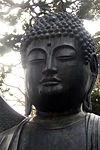
Back البوذية في الولايات المتحدة Arabic মার্কিন যুক্তরাষ্ট্রে বৌদ্ধধর্ম Bengali/Bangla Buddhalaisuus Yhdysvalloissa Finnish Bouddhisme aux États-Unis French Buddhizmus az Amerikai Egyesült Államokban Hungarian Buddhisme di Amerika Serikat ID 미국의 불교 Korean Буддизм в США Russian ศาสนาพุทธในสหรัฐ Thai Phật giáo tại Hoa Kỳ Vietnamese
| Part of a series on |
| Western Buddhism |
|---|
 |
| Part of a series on |
| Buddhism |
|---|
 |
The term American Buddhism can be used to describe all Buddhist groups within the United States, including Asian-American Buddhists born into the faith, who comprise the largest percentage of Buddhists in the country.
American Buddhists come from many national origins and ethnicities.[1][2] In 2012, U-T San Diego estimated U.S. practitioners at 1.2 million people, of whom 40% are living in Southern California.[3] In terms of percentage, Hawaii has the most Buddhists at 8% of the population, due to its large East Asian population.[4]


- ^ Kenneth K. Tanaka (January 2001). "American Buddhism's Racial Divide: Buddhists in the United States are split into two camps: Asian Americans and 'New Buddhists.' Can they be brought together?". Beliefnet.com. Archived from the original on 2008-05-12. Retrieved 2010-04-20.
- ^ Dugan, Kate; Bogert, Hilary (August 2006). "Racial Diversity and Buddhism in the U.S." (PDF). The Pluralism Project. Harvard University. Retrieved 2023-05-19.
- ^ Rowe, Peter (16 April 2012). "Dalai Lama facts and figures". U-T San Diego. Archived from the original on 8 June 2012. Retrieved 15 January 2015.
- ^ "Religious Landscape Study". Pewforum.org. 11 May 2015. Archived from the original on 19 June 2018. Retrieved 27 May 2018.